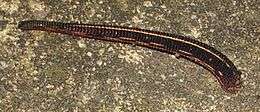Euhirudinea
| True leeches | |
|---|---|
 | |
| A true leech in a Sydney suburb | |
| Scientific classification | |
| Kingdom: | Animalia |
| Subkingdom: | Eumetazoa |
| Phylum: | Annelida |
| Class: | Clitellata |
| Subclass: | Hirudinea |
| Infraclass: | Euhirudinea |
| Orders | |
Euhirudinea, the true leeches, are an infraclass of the Hirudinea. These clitellate annelids are of somewhat unclear relationships; namely the relationships of Hirudinea with oligochaetes are in need of revision. It may be that the presumed sister taxon of the Euhirudinea, the Acanthobdellidea, turns out to be more distantly related, as was already the case with the Branchiobdellida. Thus, eventually Euhirudinea might become a junior synonym of Hirudinea.
True leeches are subdivided into two groups, the Arhynchobdellida or Arhynchobdellae (proboscisless leeches), and the Rhynchobdellida or Rhynchobdellae (jawless leeches). Note that the lack of jaws is a plesiomorphy, while the presence of a proboscis is an apomorphy - not all Arhynchobdellida have jaws, but all Rhynchobdellida have a proboscis. The most well-known leech species, Hirudo medicinalis (European Medical Leech), belongs to the Arhynchobdellida.
| Wikispecies has information related to: Euhirudinea |